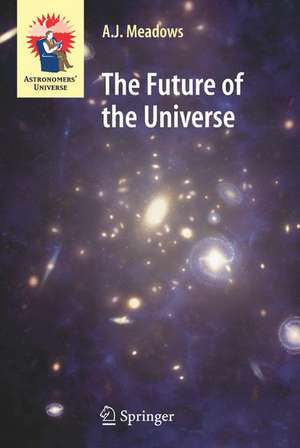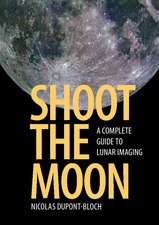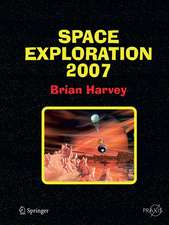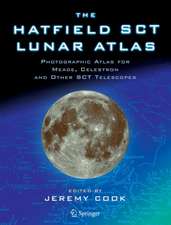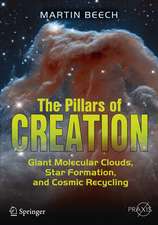The Future of the Universe: Astronomers' Universe
Autor A. J. Meadowsen Limba Engleză Hardback – dec 2006
| Toate formatele și edițiile | Preț | Express |
|---|---|---|
| Paperback (1) | 180.35 lei 3-5 săpt. | |
| SPRINGER LONDON – 28 oct 2010 | 180.35 lei 3-5 săpt. | |
| Hardback (1) | 214.86 lei 3-5 săpt. | |
| SPRINGER LONDON – dec 2006 | 214.86 lei 3-5 săpt. |
Din seria Astronomers' Universe
-
 Preț: 210.44 lei
Preț: 210.44 lei -
 Preț: 207.15 lei
Preț: 207.15 lei -
 Preț: 195.53 lei
Preț: 195.53 lei -
 Preț: 254.90 lei
Preț: 254.90 lei -
 Preț: 284.56 lei
Preț: 284.56 lei -
 Preț: 212.88 lei
Preț: 212.88 lei -
 Preț: 256.41 lei
Preț: 256.41 lei -
 Preț: 264.35 lei
Preț: 264.35 lei -
 Preț: 259.08 lei
Preț: 259.08 lei -
 Preț: 227.61 lei
Preț: 227.61 lei -
 Preț: 277.98 lei
Preț: 277.98 lei -
 Preț: 305.70 lei
Preț: 305.70 lei -
 Preț: 253.11 lei
Preț: 253.11 lei -
 Preț: 216.60 lei
Preț: 216.60 lei -
 Preț: 272.24 lei
Preț: 272.24 lei -
 Preț: 330.75 lei
Preț: 330.75 lei -
 Preț: 179.00 lei
Preț: 179.00 lei -
 Preț: 289.83 lei
Preț: 289.83 lei -
 Preț: 160.03 lei
Preț: 160.03 lei -
 Preț: 200.80 lei
Preț: 200.80 lei -
 Preț: 255.97 lei
Preț: 255.97 lei -
 Preț: 242.58 lei
Preț: 242.58 lei -
 Preț: 262.55 lei
Preț: 262.55 lei -
 Preț: 282.38 lei
Preț: 282.38 lei -
 Preț: 187.82 lei
Preț: 187.82 lei -
 Preț: 225.19 lei
Preț: 225.19 lei -
 Preț: 207.64 lei
Preț: 207.64 lei -
 Preț: 104.35 lei
Preț: 104.35 lei -
 Preț: 188.94 lei
Preț: 188.94 lei -
 Preț: 270.49 lei
Preț: 270.49 lei -
 Preț: 212.01 lei
Preț: 212.01 lei -
 Preț: 169.08 lei
Preț: 169.08 lei -
 Preț: 210.01 lei
Preț: 210.01 lei -
 Preț: 208.26 lei
Preț: 208.26 lei -
 Preț: 253.98 lei
Preț: 253.98 lei -
 Preț: 180.12 lei
Preț: 180.12 lei -
 Preț: 280.19 lei
Preț: 280.19 lei -
 Preț: 273.13 lei
Preț: 273.13 lei -
 Preț: 207.39 lei
Preț: 207.39 lei -
 Preț: 208.70 lei
Preț: 208.70 lei -
 Preț: 188.94 lei
Preț: 188.94 lei -
 Preț: 194.65 lei
Preț: 194.65 lei -
 Preț: 277.34 lei
Preț: 277.34 lei -
 Preț: 187.15 lei
Preț: 187.15 lei -
 Preț: 210.93 lei
Preț: 210.93 lei -
 Preț: 212.01 lei
Preț: 212.01 lei
Preț: 214.86 lei
Nou
Puncte Express: 322
Preț estimativ în valută:
41.11€ • 42.93$ • 34.03£
41.11€ • 42.93$ • 34.03£
Carte disponibilă
Livrare economică 14-28 martie
Preluare comenzi: 021 569.72.76
Specificații
ISBN-13: 9781852339463
ISBN-10: 1852339462
Pagini: 185
Ilustrații: X, 175 p. 29 illus., 9 illus. in color.
Dimensiuni: 155 x 235 x 21 mm
Greutate: 0.47 kg
Ediția:2007
Editura: SPRINGER LONDON
Colecția Springer
Seria Astronomers' Universe
Locul publicării:London, United Kingdom
ISBN-10: 1852339462
Pagini: 185
Ilustrații: X, 175 p. 29 illus., 9 illus. in color.
Dimensiuni: 155 x 235 x 21 mm
Greutate: 0.47 kg
Ediția:2007
Editura: SPRINGER LONDON
Colecția Springer
Seria Astronomers' Universe
Locul publicării:London, United Kingdom
Public țintă
Popular/generalCuprins
Introduction: To Begin With.- The Heat of the Sun.- The Mobile Earth.- The Earth’s Oceans and Atmosphere.- Magnetic Earth and Magnetic Sun.- Impact.- The Solar System.- Our Galaxy.- Galaxies.- The Universe.
Recenzii
From the reviews:
"A. J. Meadow’s Future of the Universe tracks not only the plan of the cosmos as a whole, but a host of futures. … Overall … I can easily recommend this book. It’s not only about the future – it’s a good primer on just about everything." (Rebecca Johnson, Sky & Telescope, August, 2007)
"The book reads easily and the language is simple. … the reader is left not only with a good clear picture of the past, present, and future of the relevant subject but also looking forward to the next instalment. … a satisfying and thought-provoking review of current cosmology, informative for the layman and capable by its brevity of inspiring some degree of lateral thinking for the serious astronomer. It has nine colour plates, an index, and advice for further reading, and I recommend it unreservedly." (Colin Cooke, The Observatory, Vol. 127 (1200), October, 2007)
"The future of everything, from the Earth to the entire Universe. … this book covers a huge range of speculations about the future of our Universe and its contents – particularly the Earth – in one volume. That, in itself, makes the Future Of The Universe a notable work. Dealing with the long-term fate of the Universe, this work deals with scenarios, such as the Big Rip, in which runaway expansion tears creation to shreds. These sections are well written … . A fascinating book. " (Marcus Chown, BBC Sky at Night, May, 2007)
"This book is a popular text about the future of the Universe. Its author was of astronomy and history of science, and so he is able to present very carefully chosen questions, where one is able to give realistic answers … . it also serves as very well founded source of knowledge about the present state of the solar system: the development of the sun and the planets, their magnetic fields, the conditions for a possible development of life at other planets etc." (Hans-Jürgen Schmidt, Zentralblatt MATH, Vol. 1106(8), 2007)
"In this welcome addition to the ‘Astronomer’s Universe’ series, Meadows, retired professor of astronomy and the history of science (Loughborough Univ., UK), offers a well-documented book taking readers on a fascinating journey through space and time, with time and distance measured on a scale of millions, billions, and trillions. … Nine color plates depict dramatic images; bibliographic sources are arranged by chapter to better facilitate readers seeking additional information on topics of interest. Summing Up: Recommended. General reader; lower-division undergraduates through professionals." (R. C. Jackman, CHOICE, Vol. 44 (11), August, 2007)
"A. J. Meadow’s Future of the Universe tracks not only the plan of the cosmos as a whole, but a host of futures. … Overall … I can easily recommend this book. It’s not only about the future – it’s a good primer on just about everything." (Rebecca Johnson, Sky & Telescope, August, 2007)
"The book reads easily and the language is simple. … the reader is left not only with a good clear picture of the past, present, and future of the relevant subject but also looking forward to the next instalment. … a satisfying and thought-provoking review of current cosmology, informative for the layman and capable by its brevity of inspiring some degree of lateral thinking for the serious astronomer. It has nine colour plates, an index, and advice for further reading, and I recommend it unreservedly." (Colin Cooke, The Observatory, Vol. 127 (1200), October, 2007)
"The future of everything, from the Earth to the entire Universe. … this book covers a huge range of speculations about the future of our Universe and its contents – particularly the Earth – in one volume. That, in itself, makes the Future Of The Universe a notable work. Dealing with the long-term fate of the Universe, this work deals with scenarios, such as the Big Rip, in which runaway expansion tears creation to shreds. These sections are well written … . A fascinating book. " (Marcus Chown, BBC Sky at Night, May, 2007)
"This book is a popular text about the future of the Universe. Its author was of astronomy and history of science, and so he is able to present very carefully chosen questions, where one is able to give realistic answers … . it also serves as very well founded source of knowledge about the present state of the solar system: the development of the sun and the planets, their magnetic fields, the conditions for a possible development of life at other planets etc." (Hans-Jürgen Schmidt, Zentralblatt MATH, Vol. 1106(8), 2007)
"In this welcome addition to the ‘Astronomer’s Universe’ series, Meadows, retired professor of astronomy and the history of science (Loughborough Univ., UK), offers a well-documented book taking readers on a fascinating journey through space and time, with time and distance measured on a scale of millions, billions, and trillions. … Nine color plates depict dramatic images; bibliographic sources are arranged by chapter to better facilitate readers seeking additional information on topics of interest. Summing Up: Recommended. General reader; lower-division undergraduates through professionals." (R. C. Jackman, CHOICE, Vol. 44 (11), August, 2007)
Notă biografică
Jack Meadows was formerly Professor of Astronomy and of the History of Science at Leicester University, UK. He is now Emeritus Professor of Information Science at Loughborough University, UK.
Textul de pe ultima copertă
A lot has been written about the history of the universe, from the Big Bang through the evolution of galaxies and stars, to the eventual appearance of life and intelligence.
Much less has been written about what comes next.
What will happen to the planets, stars, and galaxies in the distant future as the universe matures and ages? And closer to home, what will happen to mankind, and to any other intelligent life that may exist on other worlds?
Informed scientific speculation about these biggest of all questions is difficult but by no means impossible, and The Future of the Universe brings together current thinking on the subject. Beginning with a searching look at how our own Sun will probably evolve and the effect this will have on the planets of the solar system, Jack Meadows then turns his spotlight on the stars, galaxies, and clusters of galaxies. Finally he considers the various possible fates of the universe itself, and looks at our present understanding of this ultimate enigma.
Much less has been written about what comes next.
What will happen to the planets, stars, and galaxies in the distant future as the universe matures and ages? And closer to home, what will happen to mankind, and to any other intelligent life that may exist on other worlds?
Informed scientific speculation about these biggest of all questions is difficult but by no means impossible, and The Future of the Universe brings together current thinking on the subject. Beginning with a searching look at how our own Sun will probably evolve and the effect this will have on the planets of the solar system, Jack Meadows then turns his spotlight on the stars, galaxies, and clusters of galaxies. Finally he considers the various possible fates of the universe itself, and looks at our present understanding of this ultimate enigma.
Caracteristici
Uniquely, begins with the present-day universe and speculates about its long-term future Takes an in-depth look at the future of the Earth and solar system Pitched at "amateur astronomer" level, but assumes no scientific/mathematical background
